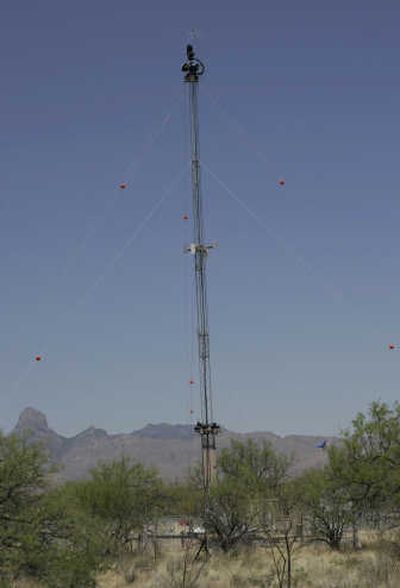White House trims ‘virtual fence’ plans

WASHINGTON – The Bush administration has scaled back plans to quickly build a “virtual fence” along the U.S.-Mexico border, delaying completion of the first phase of the project by at least three years and shifting away from linked, tower-mounted sensors and communications and surveillance gear, federal officials said Wednesday.
Technical problems discovered in a 28-mile pilot project south of Tucson prompted the change in plans, Homeland Security Department officials and congressional auditors told a House subcommittee.
While the department took over that initial stretch Friday from Boeing, authorities confirmed that Project 28, the initial deployment of its Secure Border Initiative network, did not work as planned or meet the needs of the U.S. Border Patrol.
The announcement marked a major setback for what President Bush in May 2006 called “the most technologically advanced border security initiative in American history.” The virtual fence was to be a key component of his proposed overhaul of U.S. immigration policies, which died last year in the Senate.
Investigators for the Government Accountability Office had earlier warned that the effort was beset by both expected and unplanned difficulties. But Wednesday, they disclosed new troubles that will require a redesign and said the first phase will not be completed until near the end of the next president’s first term.
The department has said that the initial effort, while flawed, still has helped it apprehend 2,000 illegal immigrants since September. It estimated in 2006 that it would spend $7.6 billion through 2011 to secure the entire 2,000-mile southern border, an ambition that was meant to win support from conservatives for a new law creating a guest-worker program and a path to legalization for 12 million illegal immigrants.
But officials Wednesday said they now expect only to complete the first phase of the virtual fence’s deployment – roughly 100 miles near Tucson, Yuma, Ariz., and El Paso – by the end of 2011, instead of by the end of 2008.
The virtual fence was to complement a physical fence that the administration now says will include 370 miles of pedestrian fencing and 300 miles of vehicle barriers on the border that was to be completed by the end of this year. The GAO said this portion of the project may also be delayed and that its total cost cannot be determined.
The pilot virtual fence included nine mobile towers, radar, cameras, and vehicles retrofitted with laptops and satellite phones or handheld devices. They were to be linked to a near-real-time, maplike projection of the frontier that agents could use to track targets and direct law enforcement resources.
GAO investigators said that Boeing selected software designed for police dispatchers that could not initially process the massive amounts of sensor data. As a result, imagery could not instantly reach a Tucson command center 65 miles to the north, making it hard for operators to lock cameras on targets.
Radar systems were also triggered inadvertently by rain and other environmental factors. Cameras had trouble resolving images at five kilometers when they were expected to work at twice that distance, said Richard Stana, the GAO’s director of homeland security and justice issues.
He added that the system was developed with “minimal input” from Border Patrol agents, resulting in an unworkable “demonstration project” instead of an operating pilot system. He blamed the DHS for acting too hastily in trying to deliver a working pilot by last June.